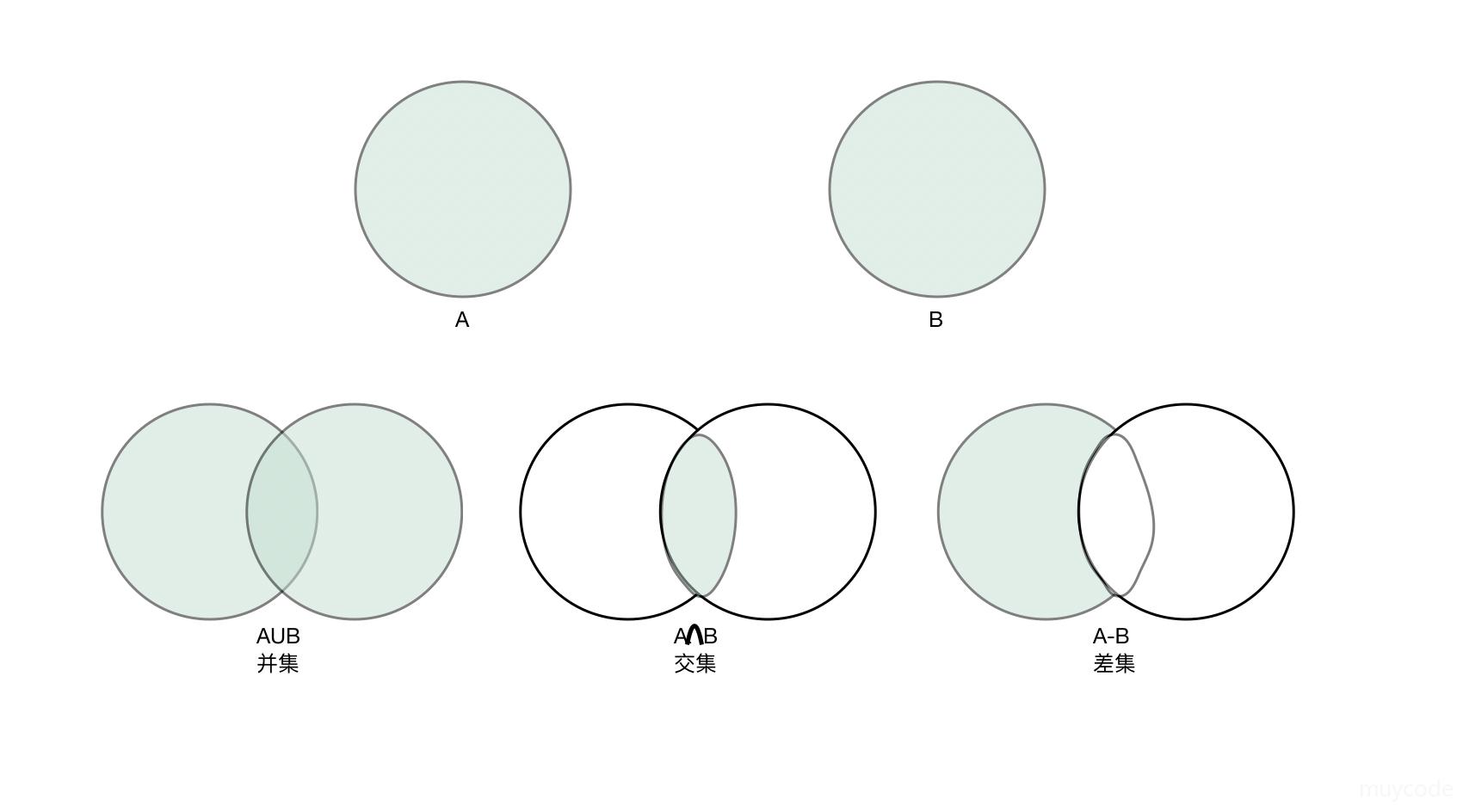什么是集合

集合是由一组无序且唯一(即不能重复)的项组成的。该数据结构使用了与有限集合相同的数学概念,但应用在计算机科学的数据结构中。
在数学中,集合是一组不同对象的集。
还有一个概念叫空集。空集就是不包含任何元素的集合,空集用{ }表示。
你也可以把集合想象成一个既没有重复元素,也没有顺序概念的数组。
在数学中,集合也有并集、交集、差集等基本运算。
集合是数学中基础的概念,在计算机领域也非常重要。它在计算机科学中的主要应用之一是数据库,而数据库是大多数应用程序的根基。集合被用于查询的设计和处理。当我们创建一条从关系型数据库(Oracle、Microsoft SQL Server、MySQL 等)中获取一个数据集合的查询语句时,使用的就是集合运算,并且数据库也会返回一个数据集合。当我们创建一条 SQL 查询命令时,可以指定是从表中获取全部数据还是获取其中的子集;也可以获取两张表共有的数据、只存在于一张表中的数据(不存在于另一张表中),或是存在于两张表内的数据(通过其他运算)。这些SQL 领域的运算叫作联接,而 SQL 联接的基础就是集合运算。
代码实现
以下是基于 ES2015 的 Set 类的设计概念,来实现我们自己的 Set 类(也会实现一些原生 ES2015没有提供的集合运算,例如并集、交集和差集)
1
2
3
4
5
6
7
8
9
10
11
12
13
14
15
16
17
18
19
20
21
22
23
24
25
26
27
28
29
30
31
32
33
34
35
36
37
38
39
40
41
42
43
44
45
46
47
48
49
50
51
52
53
54
55
56
57
58
59
60
61
62
63
64
65
66
67
68
69
70
71
72
73
74
75
76
77
78
79
80
81
82
83
84
85
86
87
88
89
90
91
92
93
94
95
96
97
98
99
100
101
102
103
104
105
106
107
108
109
110
111
112
113
114
115
116
117
118
119
120
121
122
123
124
125
126
127
128
129
130
131
132
133
134
135
136
137
138
139
140
141
142
143
144
145
146
147
148
149
150
151
152
153
154
155
156
157
158
159
160
161
162
163
164
165
166
167
168
169
170
171
172
|
export class Set {
constructor() {
this.items = {};
}
add(element) {
if (!this.has(element)) {
this.items[element] = element;
return true;
}
return false;
}
delete(element) {
if (this.has(element)) {
delete this.items[element];
return true;
}
return false;
}
has(element) {
return Object.prototype.hasOwnProperty.call(this.items, element);
}
values() {
return Object.values(this.items);
}
union(otherSet) {
const unionSet = new Set();
this.values().forEach(value => unionSet.add(value));
otherSet.values().forEach(value => unionSet.add(value));
return unionSet;
}
intersection(otherSet) {
const intersectionSet = new Set();
const values = this.values();
const otherValues = otherSet.values();
let biggerSet = values;
let smallerSet = otherValues;
if (otherValues.length - values.length > 0) {
biggerSet = otherValues;
smallerSet = values;
}
smallerSet.forEach(value => {
if (biggerSet.includes(value)) {
intersectionSet.add(value);
}
});
return intersectionSet;
}
difference(otherSet) {
const differenceSet = new Set();
this.values().forEach(value => {
if (!otherSet.has(value)) {
differenceSet.add(value);
}
});
return differenceSet;
}
isSubsetOf(otherSet) {
if (this.size() > otherSet.size()) {
return false;
}
let isSubset = true;
this.values().every(value => {
if (!otherSet.has(value)) {
isSubset = false;
return false;
}
return true;
});
return isSubset;
}
isEmpty() {
return this.size() === 0;
}
size() {
return Object.keys(this.items).length;
}
clear() {
this.items = {};
}
toString() {
if (this.isEmpty()) {
return '';
}
const values = this.values();
let objString = `${values[0]}`;
for (let i = 1; i < values.length; i++) {
objString = `${objString},${values[i].toString()}`;
}
return objString;
}
}
|
